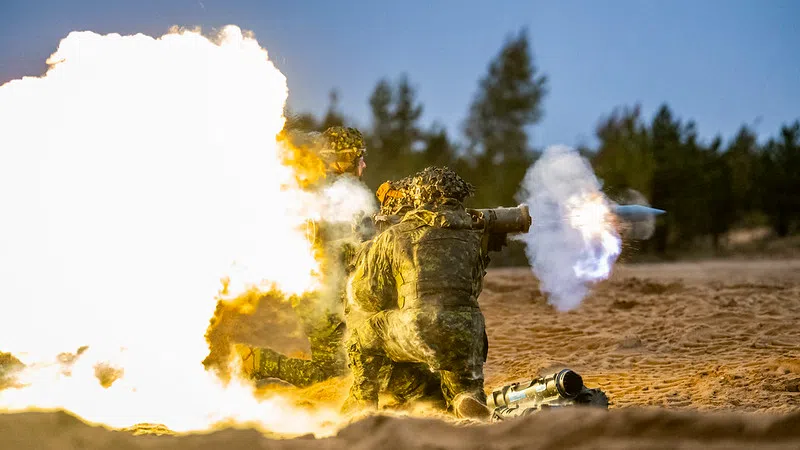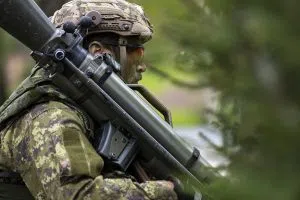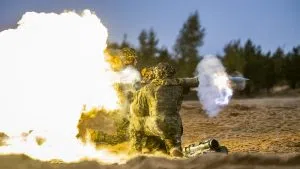A construction project is getting underway at the 4th Canadian Division Training Centre in Meaford and you may see hundreds of dump trucks heading to the base.
They’ll be carrying thousands of tonnes of various forms of aggregate.
Lt.-Col. Joe Tobin is the Base Commander in Meaford. He says two practice ranges will be updated to meet range safety requirements that have changed in recent years.
One will be the Paardeberg Range which is used for anti-armour systems like the M-72 disposable rocket-propelled grenade or the Carl Gustaf 84mm recoilless rifle.
The other range is the Cassino range where a 40mm grenade launcher the M-203 is used.
The planning process for the work has been underway for years, and because they are ranges where explosives have been fired, they’ve been working to clear the ranges of unexploded explosive ordnance (UXO) since 2018 in order to allow the construction to go ahead.
The pandemic was one reason the work didn’t go as quickly as initially expected. There were also environmental studies that needed to be done to protect at-risk species including a type of bird that nests there and a particular type of frog. “We take the environmental stewardship responsibility quite seriously,” says Tobin.
The ranges haven’t been used in the past couple of years while the clearing and environment work was being done.
Tobin explains, “Once you start doing a UXO clearance on something you’re not going to then turn around and continue to fire on it. So it’s been out of commission since 2022.”
He says going forward, on the Paardeberg Range, instead of firing at old tanks and armoured vehicles, they’ll now be firing at large, steel, two-dimensional vehicle shaped targets. Tobin says, “It’s much safer that way because it’s easy to replace, you don’t have to go digging around in unexploded bits to go and replace it, and it’s much more environmentally friendly too.”
On the Paardeberg range about 250m by 300m of land will be cleared, graded, given a granular surface, berm installed, some ditch work, and culvert installation among other remediation work.
Meanwhile road reinforcement work is also being done to allow for the transport of hundreds of dump trucks of aggregate. They’re expecting 40 to 50 trucks a day until the end of November.
Tobin explains, “Right now if you look at these ranges, it looks kind of like an overgrown field that would would see in a wild area. If you’re firing a dud-producing ammunition into a wild overgrown area, it’s very dangerous because you can’t see where you’re stepping.”
He adds, “We’re taking out all of that brush, doing the clearance and then we’re bringing in hundreds of thousands of tonnes of gravel and putting down these rocks and basically making a neat, tidy gravel pad to put these targets on, so if you do have duds that impact, and they’re laying out on the gravel, it’s very easy to find them and dispose of them as opposed to going looking though thick underbrush.”
Tobin says at the 4th Canadian Division Training Centre, the primary focus is on delivering individual training for new soldiers who have joined the Canadian Army, adding “We also do junior leader development once they’ve been in the armed forces for a few years.”
He says, “We train them up from being a basic CAF member to being an infantry soldier before we send them off to their battalions. The training that we give them here spans everything from doing manoeuvres wearing body armour and fighting gear to firing all of the weapon systems that an infanteer is going to use once they arrive at an operational unit.”
“That typically includes anti-armour weapons systems like the ones we fire on Paardeberg Range and handheld grenade launchers like the ones that we would fire on Cassino Range,” says Tobin.
He notes, “It’s important that we give them this training opportunity before they go to their battalions, because the time that they’ll have in battalions before they end up on operations is quite short. In fact, the division where most of these soldiers will be going is getting ready to start mounting operations again this July and they’ll be doing that consistently for two years.”
Tobin says they’ll be going to Latvia with the 2nd Canadian Mechanized Brigade Group.
“It’s a critical training venue for these new soliders that are coming in to make sure that they have the skills that they need to fight and win wars on behalf of Canada and to go and deploy overseas.”
The base is also a training venue which is often used by reserve units from around Ontario, including the Grey and Simcoe Foresters. Some of those reserve units will be augmenting the 2nd Canadian Mechanized Brigade Group when they deploy.
The work on the two ranges is pegged at $1.7 million for the Paardeberg range and is expected to be ready for summer 2025. The Cassino range is pegged at $2.4 million to be ready for fall 2025.
In the meantime, training will continue at the base.






